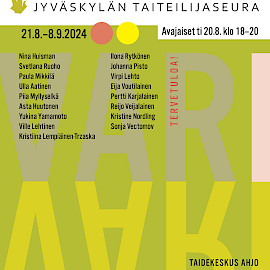News
ART CENTER AHJO, SYSI -HALL: Jyväskylä's Artist Association
VÄRISUHTEITA
VISITING EXHIBITION OF JYVÄSKYLÄ ARTIST SOCIETY
21.8. - 8.9.2024, SYSI SALI
Ulla Aatinen, Nina Huisman, Asta Huutonen, Pertti Karjalainen, Ville Lehtinen, Virpi Lehto, Kristiina Lempiäinen-Traz- ka, Paula Mikkilä, Piia Myllyselkä, Kristine Nordling, Johanna Pisto, Svetlana Ruoho, Ilona Rytkönen, Reijo Veijalainen, Sonja Vectomov, Eija Voutilainen, Yukina Yamamoto
The Jyväskylä Artists' Society's exhibition Color relations has been inspired by the color-themed exhibition series organized in 2022 at the Jyväskylä Art Museum. The three exhibitions were curated by art historian Marjo-Riitta Simpanen, who has also written a history of the Jyväskylä Artists' Association (1992). The Jyväskylä Artist's Association has approx. 150 members, of which 17 artists offered their works for the Värisuhteita exhibition. The exhibition was curated based on the offer by the club's artists Hannu Castrén and Minja Revonkorpi. At the same time, Revokorpi's solo exhibition Puutarhaunia is on display in Ahjo, and in the viewing experience, it is the color that smoothly connects his paintings to the Värisuhteita exhibition.
The history of Finnish color art goes back to the beginning of the last century, and the history of central Finnish color art is roughly the same length. Jonas Heiska (1873-1937) and Carl Bengts (1876-1934) wavered in their artist identity between national romantic art and international post-impressionism. Urho Lehtinen (1887-1982), who was younger than them, did study under the Golden Age artists, but he was already aware of the art of the Septem group and the November People. Even at "Picasso's" age, he found motifs for his colorist in the flowers of his garden. Yrjö Saarinen (1899-1958) was a self-taught natural talent, for whose expressionism color in all its effects was an inner necessity. If the atmosphere of our time's art culture sometimes feels stressfully pressured, you can still seek Bohemian medicine from Saarinen. Even when dosed carefully, it raises creative stubbornness in the artist.
Jyväskylä Taiteilijaseura was founded in 1945. Within the circle of the society, it became known that during the wars the international development of art had been left behind. When there was no art school in Central Finland, summer courses were organized within the circle of the club. The summer courses in Korpilahti (1948-1957) were several weeks long at most. In the middle of nature, the artists studied the styles of modernism while painting the landscape, where the focus was the abstraction of visible reality and the idea of color and the interrelationships of colors also as independent elements of a work of art. A few of us remembers that the ARS61 exhibition was also on display in Jyväskylä and had a decisive impact on the development of Central Finnish art. The exhibition was like a last touch for the young artists of the time: the principle of abstraction developed into full non-representability, above all with informalism, lyrical abstractism and kinetic art, and color dominated every new -ism. Kyösti Sorjonen (1912-1996), founding member of the artists' society and art critic, defined the art of the region with a special emphasis on color by adopting the concept of Central Finnish color painting. He stated that when he entered the national joint performances, he could already see from afar where there were paintings by Central Finns.
A backlash against modernism and the avant-garde that accelerated it also arose in Finnish art in the 1980s. The new generation of artists no longer agreed to follow the kind of artistic freedom where a certain style/-ism ultimately limits the freedom to certain rules, the violation of which the critic shakes his finger at. In this postmodernist (cf. postmodernism) phase, artists began to consciously break stylistic boundaries, mix styles with each other as they pleased, "sampling from Figurative to abstract or vice versa and they no longer cared about the sharp hierarchy between high and popular culture. So it's no wonder that, for example, aniline, which was shunned by modernism, started to appear in the color palette, and its presence on the painting surface is still enjoyed today. Even decades later, this kind of diversity based on the artist's individual choices, personality and identity flourishes and gives rise to interesting visual art. However, artists no longer need to approach their work through various counter-reactions, but a strong feeling that what is now being born is the most authentic me is enough for them.
Hannu Castrén, Jyväskylä Artists' Association

